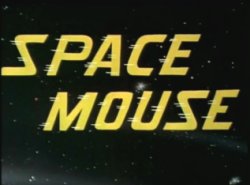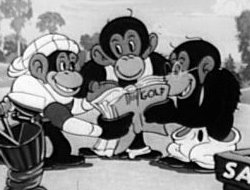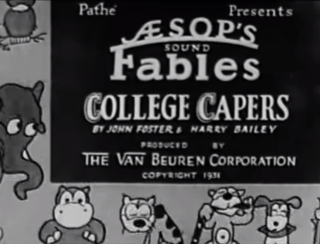
Oswald the Lucky Rabbit is an animated cartoon character created in 1927 by Walt Disney and Ub Iwerks for Universal Pictures. He starred in several animated short films released to theaters from 1927 to 1938. Twenty-seven animated Oswald shorts were produced at the Walt Disney Studio. After Universal took control of Oswald's character in 1928, Disney created a new character similar in appearance to Oswald as a replacement: Mickey Mouse, who went on to become one of the most famous cartoon characters in the world.

Walter Lantz Productions was an American animation studio. It was in operation from 1928 to 1972 and was the principal supplier of animation for Universal Pictures.

Woody Woodpecker is an animated character that appeared in theatrical short films produced by the Walter Lantz Studio and Universal Animation Studio and distributed by Universal Pictures since 1940. Woody's last Woody Woodpecker was produced by Walter Lantz in 1972.

Walter Benjamin Lantz was an American cartoonist, animator, producer and director best known for founding Walter Lantz Productions and creating Woody Woodpecker.
Andy Panda is a cartoon character who starred in his own series of animated cartoon short subjects produced by Walter Lantz. These "cartunes" were released by Universal Pictures from 1939 to 1947, and United Artists from 1948 to 1949. The title character is an anthropomorphic cartoon character, a cute panda. Andy became the second star of the Walter Lantz cartoons after Oswald the Lucky Rabbit. He achieved considerable popularity until being eventually supplanted by Woody Woodpecker.
Thomas Augustin Palmer was an Italian-American animator, cartoon director, and U.S. training film supervisor. He was active in the animation industry throughout the 1920s and 1930s and was best known for his animation work at Walt Disney Productions. He spent a good chunk of his later career directing training films for the United States Army.

The following is a complete list of Oswald the Lucky Rabbit's appearances in cartoons, films, video games, etc.

The first Space Mouse is a comic book character published from 1953 to around 1956 by Avon Publications. Space Mouse is also the name of a 1959 Universal Studios cartoon featuring two mice and a cat named Hickory, Dickory, and Doc. A second Space Mouse character was published by Dell Comics from 1960 to around 1965. The Dell Comics version was also featured in a 1960 cartoon produced by Walter Lantz, entitled The Secret Weapon.

Meany, Miny, and Moe are animated characters created by Walter Lantz, who made their first appearance in the Oswald the Lucky Rabbit cartoon Monkey Wretches (1935). Their final animated appearance was in 1937 in The Air Express.

The Shriek is a 1933 animated short film produced by Walter Lantz Productions as part of the Oswald the Lucky Rabbit series. The cartoon's title is a parody of the 1921 Paramount film The Sheik.

Carnival Capers is a 1932 animated short film featuring Oswald the Lucky Rabbit. It is the 65th Oswald cartoon by Walter Lantz Productions and the 117th in the entire series.
Puppet Show is a 1936 short film from Walter Lantz Productions and stars Oswald the Lucky Rabbit. Unlike most shorts made by the studio, the film employs both animation and live-action.
The hurdy-gurdy is a musical instrument.

Swing Symphony is an American animated musical short film series produced by Walter Lantz Productions from 1941 to 1945. The shorts were a more contemporary pastiche on Walt Disney's Silly Symphonies, and often featured top boogie-woogie musicians of the era. While the first cartoon include the characters Woody Woodpecker and Andy Panda, it mainly features a variety of different characters created exclusively for the series, with Oswald the Lucky Rabbit making an appearance in one cartoon.

The Cactus Kid is a Mickey Mouse short animated film first released on May 10, 1930, as part of the Mickey Mouse film series. It was the eighteenth Mickey Mouse short to be produced, the third of that year.

Circus Capers is a 1930 animated short film made by The Van Beuren Corporation and distributed by Pathé Exchange. The film, which featured the characters Milton Mouse and Rita, is part of the early sound cartoon series entitled Aesop's Sound Fables, though it is not based on an Aesop fable.

College Capers is a 1931 animated short film produced by The Van Beuren Corporation and released by the film distributor Pathé.

Permanent Wave is a 1929 animated film which is presented by Carl Laemmle and is produced by Walter Lantz. The film, which was written and animated by Walter Lantz, Bill Nolan and Tom Palmer, features Oswald rescuing a mermaid, whom he has fallen in love with, from his captain on the ship that Oswald is controlling during the film.

Hurdy Gurdy is a 1929 animated short film which is presented by Carl Laemmle and was produced by Walter Lantz, who he and his wife would go on to make Woody Woodpecker. The film, which is animated by R.C. Hamilton, Bill Nolan and Tom Palmer, features Oswald the Lucky Rabbit, who is substituted for the organ grinder's dancer, after the original one is comically swallowed up by Oswald's bubblegum.

Chilly Con Carmen is a 1930 animated short film which was presented by Carl Laemmle and was produced by Walter Lantz, who would go on to produce Woody Woodpecker with his wife, Gracie Lantz. The film, which was animated by R. C. Hamilton, Tom Palmer and 'Bill' Nolan, features Oswald the Lucky Rabbit, as he attempts to engage in a game of bullfighting in order to charm a Mexican girl over his other girlfriend, Miss Hippo.
















